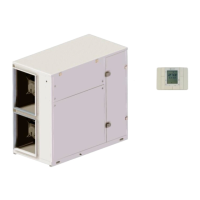9
4.3 Hydronic recovery - option
A. vent
B. filling glycol
C. water filling tap
The device is shipped filled with water and glycol.
Adopt measures to prevent risk of freezing if the unit or
relative hydraulic connections can be subject to temperatures
near 0°C.
isolate the piping
protect the piping with heating cables laid underneath
the insulation
4.2 Risk of freezing
4 - HYDRAULIC CONNECTIONS
4.1 Condensate drain
The condensate must be disposed of in order to avoid
damaging things and persons.
Unit drain coupling: the connection must not transmit
mechanical stresses and must be carried out paying
attention not to damage the unit drain coupling.
Foresee a siphon that, by eliminating the depression
caused by the fan, prevents suction of air from the drain
piping.
The piping must have adequate slope to allow out flow.
Anchor the piping with an adequate number of supports.
On the contrary, cracking in the piping and air pockets
obstructing the outflow, are generated.
Isolate piping and siphon to avoid condensate dripping.
Connect the condensate drain to a rain drain network.
DO NOT use white waters or sewage drains to avoid
possible inhaling of odours in case of evaporation of the
water contained in the si phon.
At work end, check the regular outflow of the condensate
by pouring water in the bowl.
Example :
P = 300 Pa = 30 mm
T = 2P = 60 mm
S = T/2 = 30 mm
Siphon height calculation
T = 2P
S = T/2
P is the pressure determined by the fan in correspondence of
the condensate collection bowl (approx. 1 mm = 9.81 Pa)

